Offline Setup Wizard: Difference between revisions
Bcarmichael (talk | contribs) No edit summary |
No edit summary |
||
| (One intermediate revision by the same user not shown) | |||
| Line 1: | Line 1: | ||
If your NG Firewall appliance cannot connect to the Internet and your appliance is not configured, the local [[Administration Interface]] presents you with a Setup Wizard to configure essential parameters. If your appliance is online and connected to the Internet, the configuration of essential parameters is managed through | If your NG Firewall appliance cannot connect to the Internet and your appliance is not configured, the local [[Administration Interface]] presents you with a Setup Wizard to configure essential parameters. If your appliance is online and connected to the Internet, the configuration of essential parameters is managed through ETM Dashboard. See [https://support.untangle.com/hc/en-us/articles/115004175567-Adding-Untangle-appliances-to-ETM-Dashboard Adding ETM Dashboard Appliances to ETM Dashboard] for more details. | ||
The steps below explain how to navigate through the local Setup Wizard if your appliance is offline. | The steps below explain how to navigate through the local Setup Wizard if your appliance is offline. | ||
| Line 22: | Line 22: | ||
=== Setup Wizard - Step 2 - Identify Network Cards === | === Setup Wizard - Step 2 - Identify Network Cards === | ||
The second step shows you the network cards. If this is an appliance from | The second step shows you the network cards. If this is an appliance from Edge Threat Management you can simply continue to the next step. If this is a custom server, verify that the physical network cards are mapped to the correct (desired) interface. You can verify connectivity by disconnecting or connecting the cable to the physical interface. The status icon changes immediately between grey or green to show the link state. | ||
[[Image:setup_wizard_step2_remap.png|600px|center|Setup Wizard - Step 2 Remapping]] | [[Image:setup_wizard_step2_remap.png|600px|center|Setup Wizard - Step 2 Remapping]] | ||
| Line 49: | Line 49: | ||
==== Router ==== | ==== Router ==== | ||
In '''Router''' mode, | In '''Router''' mode, NG Firewall will be the edge device on your network and serve as a router and firewall. In this case you'll need to set up your External and Internal interfaces correctly for traffic to flow, which should have been done while installing. | ||
[[Image:router_mode.png|frame|center| | [[Image:router_mode.png|frame|center|NG Firewall in Router mode]] | ||
==== Transparent Bridge ==== | ==== Transparent Bridge ==== | ||
In '''Transparent Bridge''' mode, | In '''Transparent Bridge''' mode, NG Firewall is installed behind an existing firewall and sits between your existing firewall and main switch. When in Bridge mode NG Firewall is transparent, meaning you won't need to change the default gateway of the computers on your network or the routes on your firewall - just put the NG Firewall between your firewall and main switch and that's it. You do not change the configuration of existing clients or the existing firewall! | ||
[[Image:bridge_mode.png|frame|center| | [[Image:bridge_mode.png|frame|center|NG Firewall in Bridge mode]] | ||
=== Setup Wizard - Step 5 - Configure Automatic Upgrade Settings === | === Setup Wizard - Step 5 - Configure Automatic Upgrade Settings === | ||
| Line 63: | Line 63: | ||
In the fifth step ''Automatic Upgrades'' are configured. If Automatic Upgrades is enabled, NG Firewall automatically checks for new versions and performs the upgrade between 1am and 2am every morning. You can adjust the upgrade schedule after the setup is complete from the [[Upgrade Settings]]. | In the fifth step ''Automatic Upgrades'' are configured. If Automatic Upgrades is enabled, NG Firewall automatically checks for new versions and performs the upgrade between 1am and 2am every morning. You can adjust the upgrade schedule after the setup is complete from the [[Upgrade Settings]]. | ||
This step also includes an option to manage the appliance from [https://www.untangle.com/shop/command-center/ | This step also includes an option to manage the appliance from [https://www.untangle.com/shop/command-center/ ETM Dashboard]. | ||
[[Image:setup_wizard_step5.png|600px|center|Setup Wizard - Step 5]] | [[Image:setup_wizard_step5.png|600px|center|Setup Wizard - Step 5]] | ||
Latest revision as of 20:35, 3 May 2022
If your NG Firewall appliance cannot connect to the Internet and your appliance is not configured, the local Administration Interface presents you with a Setup Wizard to configure essential parameters. If your appliance is online and connected to the Internet, the configuration of essential parameters is managed through ETM Dashboard. See Adding ETM Dashboard Appliances to ETM Dashboard for more details.
The steps below explain how to navigate through the local Setup Wizard if your appliance is offline.
Language selection
Before you begin the setup wizard, select your preferred language.
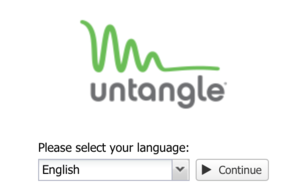
Setup Wizard - Welcome
The next screen simply welcomes you to the Setup Wizard. Click next to continue.
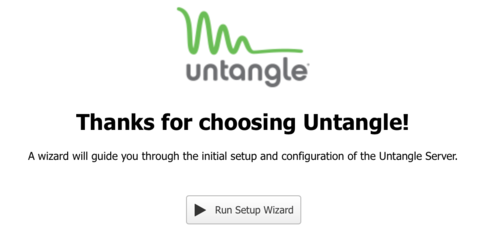
Setup Wizard - Step 1 - Configure the Server
The first step has you set a password for the administrator account and select a timezone. You can also set the admin email to receive alerts and reports. Select the installation type, which closest matches your deployment.
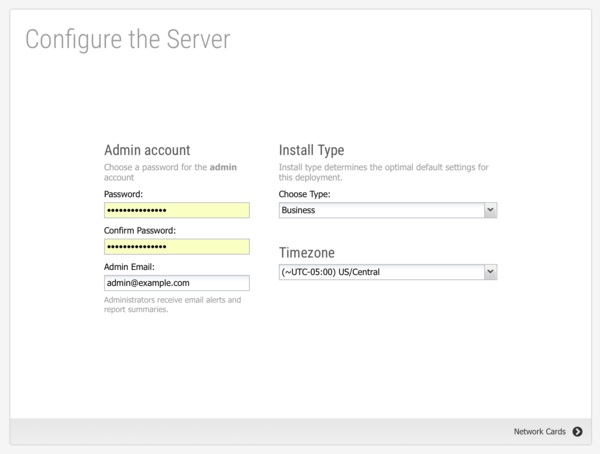
Setup Wizard - Step 2 - Identify Network Cards
The second step shows you the network cards. If this is an appliance from Edge Threat Management you can simply continue to the next step. If this is a custom server, verify that the physical network cards are mapped to the correct (desired) interface. You can verify connectivity by disconnecting or connecting the cable to the physical interface. The status icon changes immediately between grey or green to show the link state.
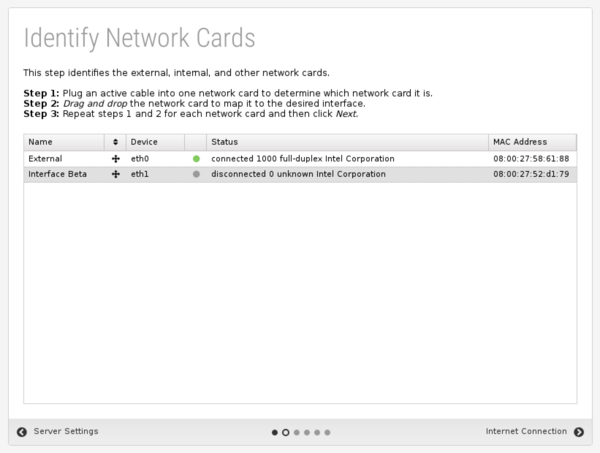
Setup Wizard - Step 3 - Configure The Internet Connection
The third step configures your External (WAN) interface.
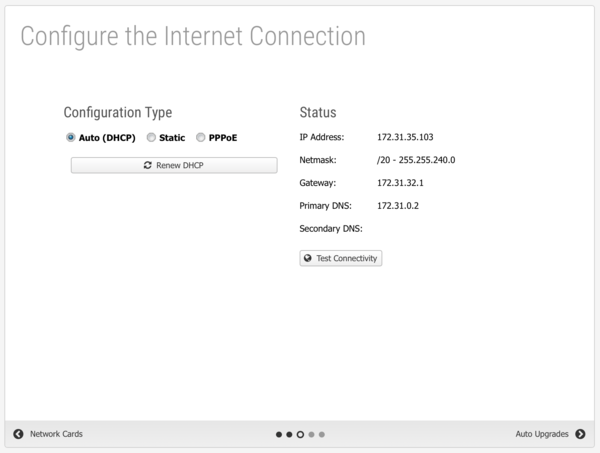
The default selection is Auto (DHCP). The automatically assigned address is displayed if an address was successfully acquired. Otherwise, click Renew DHCP to acquire an IP address. Click Test Connectivity to verify Internet access.
If your Internet connection requires a static IP address or uses PPPoE, select the appropriate option and enter the parameters assigned by your Internet Service Provider.
Setup Wizard - Step 4 - Internal Network Interface
The fourth step will configure your "Internal" interface (and DHCP server and NAT configuration.) There are two choices.
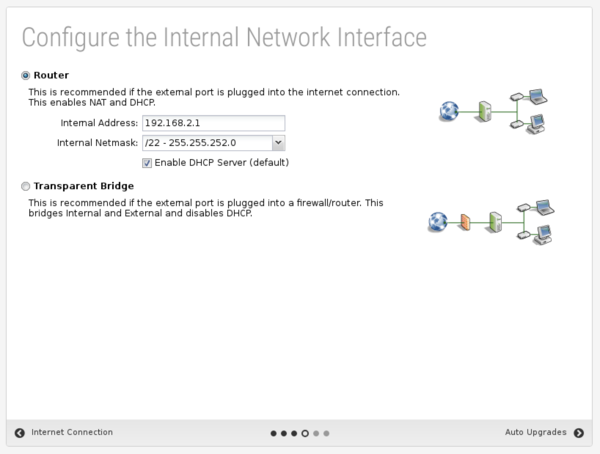
You can configure the internal interface with private static IP address (ie 192.168.2.1) and enable DHCP serving and NAT (Network Address Translation) so all internal machines will have private addresses and share one public IP. This is commonly referred to as Router mode.
You can also configure the internal interface to be bridged to the external. In this mode the internal interface does not have its own address and is simply shares the External's address. This is commonly referred to as Transparent Bridge mode.
Router
In Router mode, NG Firewall will be the edge device on your network and serve as a router and firewall. In this case you'll need to set up your External and Internal interfaces correctly for traffic to flow, which should have been done while installing.
Transparent Bridge
In Transparent Bridge mode, NG Firewall is installed behind an existing firewall and sits between your existing firewall and main switch. When in Bridge mode NG Firewall is transparent, meaning you won't need to change the default gateway of the computers on your network or the routes on your firewall - just put the NG Firewall between your firewall and main switch and that's it. You do not change the configuration of existing clients or the existing firewall!
Setup Wizard - Step 5 - Configure Automatic Upgrade Settings
In the fifth step Automatic Upgrades are configured. If Automatic Upgrades is enabled, NG Firewall automatically checks for new versions and performs the upgrade between 1am and 2am every morning. You can adjust the upgrade schedule after the setup is complete from the Upgrade Settings.
This step also includes an option to manage the appliance from ETM Dashboard.
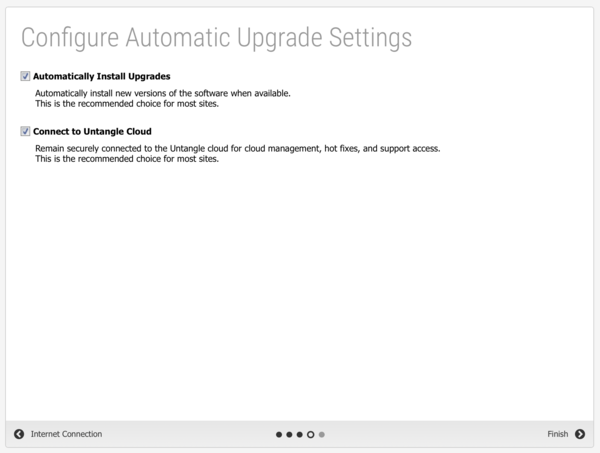
Setup Wizard - Finished
That's it!
